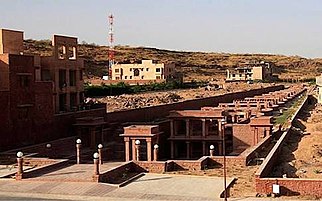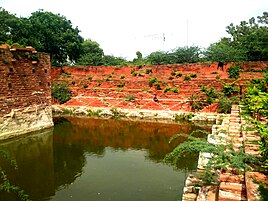Stepwell
This article includes a list of generalreferences,butit lacks sufficient correspondinginline citations.(May 2022) |



Stepwells(also known asvavsorbaori) arewells,cisternsor ponds with a long corridor of steps that descend to the water level. Stepwells played a significant role in defining subterranean architecture in western India from the 7th to the 19th century.[1]Some stepwells are multi-storeyed and can be accessed by aPersian wheelwhich is pulled by abullto bring water to the first or second floor. They are most common in westernIndiaand are also found in the other more arid regions of theIndian subcontinent,extending intoPakistan.The construction of stepwells is mainlyutilitarian,though they may include embellishments of architectural significance, and betemple tanks.
Stepwells are examples of the many types of storage andirrigation tanksthat were developed in India, mainly to cope with seasonal fluctuations in water availability. A basic difference between stepwells on one hand, and tanks and wells on the other, is that stepwells make it easier for people to reach the groundwater and to maintain and manage the well.
The builders dug deep trenches into the earth for dependable, year-round groundwater. They lined the walls of these trenches with blocks of stone, withoutmortar,and created stairs leading down to the water.[2]This led to the building of some significant ornamental and architectural features, often associated with dwellings in urban areas. It also ensured their survival as monuments.
A stepwell structure consists of two sections: a vertical shaft from which water is drawn and the surrounding inclined subterranean passageways and the chambers and steps which provide access to the well. The galleries and chambers surrounding these wells were often carved profusely with elaborate detail and became cool, quiet retreats during the hot summers.[3]
Names
[edit]A number of distinct names, sometimes local, exist for stepwells. InHindi-speaking regions, they include names based onbaudi(includingbawdi (Rajasthani:बावड़ी),bawri,bawari,baori,baoli,bavadiandbavdi). InGujaratiandMarwari language,they are usually calledvav, vavriorvaav(Gujarati:વાવ). Other names includekalyani or pushkarani(Kannada),baoli(Hindi:बावली),barav(Marathi:बारव) anddegeenar(Bhojpuri:𑂙𑂵𑂏𑂲𑂢𑂰𑂩).
History
[edit]
The stepwell may have originated during periods of drought to ensure enough access to the water. The earliest archaeological evidence of stepwells is found atDholavirawhere the site also has water tanks or reservoirs with flights of steps. Mohenjo Daro's great bath is also provided with steps on opposite directions.Ashokan inscriptionsmention construction of stepwells along major Indian roads at a distance of every 8kos(about 20.8 miles or 33.5 km) for the convenience of travellers, but Ashoka states that it was a well-established practice which predated him and was done by former kings as well.
King Devanampriya Priyadarsin speaks thus. On the roads banyan-trees were caused to be planted by me, (in order that) they might afford shade to cattle and men, (and) mango-groves were caused to be planted. And (at intervals) of eight kos wells were caused to be dug by me, and flights of steps (for descending into the water) were caused to be built. Numerous drinking-places were caused to be established by me, here and there, for the enjoyment of cattle and men. [But] this so-called enjoyment (is) [of little consequence]. For with various comforts have the people been blessed both by former kings and by myself. But by me this has been done for the following purpose: that they might conform to that practice of morality.
— Ashokan Pillar Edict No 7
The first rock-cut stepwells in India date from 200 to 400 AD.[4]The earliest example of a bath-like pond reached by steps is found atUperkot cavesinJunagadh.These caves are dated to the 4th century. Navghan Kuvo, a well with the circular staircase in the vicinity, is another example. It was possibly built inWestern Satrap(200–400 AD) orMaitraka(600–700 AD) period, though some place it as late as the 11th century. The nearbyAdi Kadi Vavwas constructed either in the second half of the 10th century or the 15th century.[5]
The stepwells atDhankinRajkot districtare dated to 550–625 AD. The stepped ponds atBhinmal(850–950 AD) are followed by it.[4]The stepwells were constructed in the southwestern region of Gujarat around 600 AD; from there they spread north to Rajasthan and subsequently to the north and west India. Initially used as an art form by Hindus, the construction of these stepwells hit its peak during Muslim rule from the 11th to 16th century.[3]
One of the earliest existing examples of stepwells was built in the 11th century in Gujarat, theMata Bhavani's Stepwell.A long flight of steps leads to the water below a sequence of multi-story open pavilions positioned along the east–west axis. The elaborate ornamentation of the columns, brackets and beams are a prime example of how stepwells were used as a form of art.[6]
TheMughal emperorsdid not disrupt the culture that was practiced in these stepwells and encouraged the building of stepwells. The authorities during theBritish Rajfound the hygiene of the stepwells less than desirable and installed pipe and pump systems to replace their purpose.[6]
Location of a stepwell
[edit]A stepwell is generally located in two places - as an extension or part of a temple, and/or the outskirts of a village.[2]When a stepwell is associated with a temple or a shrine, it is either at the opposite wall of it or in front of the temple. Sindhvai Mata stepwell in Patan, Mata Bhavani stepwell in Ahmedabad, and the Ankol Mata stepwell in Davad serve as a great example of the stepwells that house shrines.[2]
Function and use
[edit]The stepwell ensures the availability of water during periods of drought. The stepwells had social, cultural and religious significance.[6]These stepwells were proven to be well-built sturdy structures, after withstandingearthquakes.[2]Most places in India where there is abundant fresh water only during themonsoonseason, stepwell and wells play a critical role in serving as a direct means to fresh water filtered through the earth. While the rivers,rivulets,creeks, and other natural water bodies dry up in this climate zone, stepwell and wells remain at a depth where there is less exposure to sun and heat.[2]The majority of surviving stepwells originally served a leisure purpose alongside being main source of water for basic needs like bathing, washing clothes, farming, and watering animals. Stepwells also served as a place for social gatherings and religious ceremonies. Usually, women were more associated with these wells because they were the ones who collected the water. Also, it was they who prayed and offered gifts to the goddess of the well for her blessings.[2]
The well-water is known to attract insects, animals, and many other germ breeding organisms. These stepwells, being a common space in frequent use by the inhabitants of the area, were considered to be a source of spreadingepidemicsand diseases.[2]
Details
[edit]Many stepwells have ornamentation and details as elaborate as those of Hindu temples. Proportions in relationship to the human body were used in their design, as they were in many other structures in Indian architecture.[7]
Stepped ponds
[edit]

Stepped ponds are very similar to stepwells in terms of purpose. Generally, stepped ponds accompany nearby temples while stepwells are more isolated.[8]Stepwells are dark and barely visible from the surface, while stepped ponds are illuminated by the light from the sun. Stepwells are more linear in design compared to the rectangular shape of stepped ponds.[7]
In India
[edit]
A number of survivingsignificant stepwells inIndia:can be found across India, including inRajasthan,Gujarat,Delhi,Madhya Pradesh,Maharashtra,andNorth Karnataka(Karnataka). In 2016 acollaborative mappingproject, Stepwell Atlas,[9]started to mapGPS coordinatesand collate information on stepwells, mapping over 2800 stepwells in India. Another project mapped the location of over 1700 stepwells in Maharashtra.[10]
- Stepwells of Delhi & Haryana:
In his bookDelhi Heritage: Top 10 Baolis,Vikramjit Singh Roopraimentions that Delhi alone has 32 stepwells.[11]Out of these, 16 are lost, but their locations can be traced. Of the remaining 16, only 14 are accessible to public and the water level in these keeps varying, while two are now permanently dry.
- Rani ki vavatPatan
- Adalaj ni VavatAdalaj,Gandhinagar
- Dada Harir Stepwell,Ahmedbad
- Navghan KuvoandAdi Kadi vav,Uparkot Fort, Junagadh
- Kalyani, Hulikere
- Bhoga Nandeeshwara Temple, Karnataka
- Charthana Stepwell, Parbhani
- Pingli Stepwell, Parbhani
- Arvi Stepwell, Parbhani
- Bundi:has over 60 baolis in and around the town.
- Raniji ki Baoriin Bundi
- Jaipur:
- Neem Ka Thana
- Udoji ki BaoriatMandholi5km north of Neem ka Thana on Neem ka Thana-Mandholi-Khetri highway.
In Pakistan
[edit]
Stepwells fromMughalperiods still exist inPakistan.Some are in preserved conditions while others are not.
- Bahar Wali Baoli, inKharian
- Rohtas Fort,nearJhelum
- Wan Bhachran,nearMianwali
- Losar Baoli,nearIslamabad
- MakliBaoli, nearThatta
Influence
[edit]
Stepwells influenced many other structures in Indian architecture, especially those that incorporate water into their design.[3]For example, theAram BaghinAgrawas the firstMughal gardenin India.[7]It was designed by the Mughal emperorBaburand reflected his notion of paradise not only through water and landscaping but also through symmetry by including a reflecting pool in the design. He was inspired by stepwells and felt that one would complement the garden of his palace. Many other Mughal gardens include reflecting pools to enhance the landscape or serving as an elegant entrance. Other notable gardens in India which incorporate water into their design include:
- Humayun's Tomb,Nizamuddin East,Delhi
- Taj Mahal,Agra
- Mehtab Bagh,Agra
- Safdarjung's Tomb
- Shalimar Bagh (Srinagar),Jammu and Kashmir
- Nishat Gardens,Jammu and Kashmir
- Yadvindra Gardens,Pinjore
- Khusro Bagh,Allahabad
- Roshanara Bagh
Gallery
[edit]-
Large stepwell at Nagnath Mandir in Hatnoor Village, Parbhani District in Maharashtra
-
View of a stepwell atFatehpur, Shekhawati
-
The 18th-century Baoli Ghaus Ali Shah, inFarrukhnagar,Haryana
-
Birkha Bawari,a stepwell atJodhpur
-
Toor Ji Ka Jhalra, stepped well,Jodhpur
-
Stepped well,Hampi
See also
[edit]- Ancient India
Notes
[edit]- ^Priya, T.Lakshmi (October 2010)."Protecting the Tangible and Intangible Heritage of Rani ki Vav: A Unique Subterranean Step Well in Gujarat".Advanced Materials Research.133–134: 1057–1064.doi:10.4028/ scientific.net/AMR.133-134.1057.ISSN1662-8985.
- ^abcdefgShekhawat, Abhilash."Stepwells of Gujarat".India's Invitation.Retrieved30 March2012.
- ^abcDavies, Philip (1989).The Penguin guide to the monuments of India.London: Viking.ISBN0-14-008425-8.
- ^abLivingston & Beach, p. xxiii
- ^Jutta Jain-Neubauer (1981).The Stepwells of Gujarat: In Art-historical Perspective.Abhinav Publications. pp. 19–25.ISBN978-0-391-02284-3.
- ^abcTadgell, Christopher (1990).The History of Architecture in India.London: Phaidon Press.ISBN0-7148-2960-9.
- ^abcLivingston, Morna (2002).Steps to Water: The Ancient Stepwells of India.New York: Princeton Architectural.ISBN1-56898-324-7.
- ^Jain-Neubauer, Jutta (1981).The Stepwells of Gujarat: In art-historical Perspective.New Delhi: Abhinav.ISBN0-391-02284-9.
- ^Stepwell Atlas
- ^"Maharashtra Stepwells".Maharashtra Stepwells.Retrieved23 March2021.
- ^Rooprai, Vikramjit Singh (2019).Delhi heritage: Top 10 baolis.Niyogi Books.ISBN978-9-38913-611-1.
- ^Sengar, Resham."Sri Subramanya Temple in Peralassery – its legend, the stepwell and resident snakes".The Times of India.Retrieved10 March2020.
- ^Datta, Rangan (13 March 2023)."Hyderabad's Bansilalpet stepwell: Ravaged, reimagined, then revived".No. My Kolkata. The Telegraph.Retrieved20 March2023.
References
[edit]- Rima Hooja: "Channeling Nature: Hydraulics, Traditional Knowledge Systems, And Water Resource Management in India – A Historical Perspective".At infinityfoundation
- Livingston, Morna & Beach, Milo (2002).Steps to Water: The Ancient Stepwells of India.Princeton Architectural Press.ISBN1-56898-324-7.
- Vikramjit Singh Rooprai.Delhi Heritage: Top 10 Baolis(2019). Niyogi Books.ISBN9-38913-611-3.
- Jutta Jain NeubauerThe Stepwells of Gujarat: An art-historical Perspective(2001)
- Philip Davies, The Penguin guide to the monuments of India, Vol II (London: Viking, 1989)
- Christopher Tadgell, The History of Architecture in India (London: Phaidon Press, 1990)
- Abhilash Shekhawat, "Stepwells of Gujarat." India's Invitation. 2010. Web. 29 March 2012.<http:// indiasinvitation /stepwells_of_gujarat/>.
- Stepwells in IndiaatCurlie
- "Architecture of the Indian Subcontinent – glossary".Indoarch.org.Retrieved18 December2006.
Further reading
[edit]Azmi, Feza Tabassum.The ancient stepwells helping to curb India's water crisis,BBC









